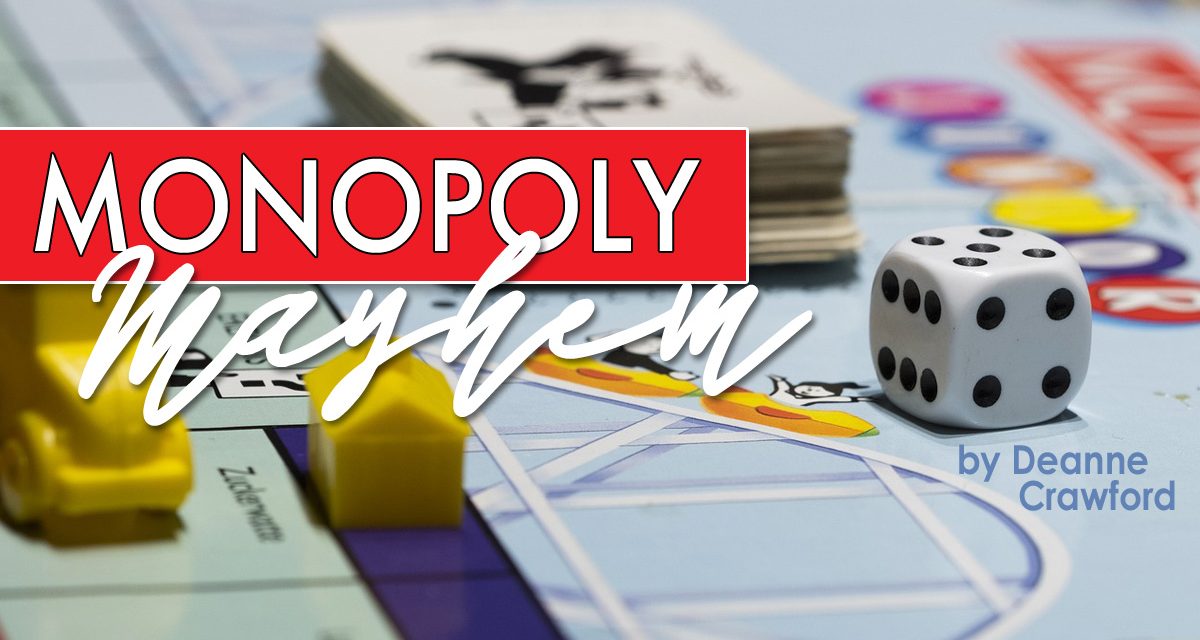Love it or hate it, the story of the famous game of Monopoly® is bursting with controversy, financial theories, prison escapes, and more. March 7th celebrates the creation of the game still popular today.
For years, many people celebrated Monopoly® as the one good thing to come from the Great Depression. The story goes that an unemployed heating salesman from Pennsylvania dreamed up the idea while playing games with his family. As a family project, Charles Darrow, his wife and son, William, hand drew the game board on oil cloth. They collected common items like buttons and bottle caps to use as game pieces. Success came quickly with his self-published game, but he was unable to keep up with demand. He approached Milton Bradley Games, who rejected the game because it was “too complicated … and took too long to play.” Next, he tried Parker Brothers, who also rejected it, until they noticed how quickly the self-published game sold during the Christmas season. Remember, this was during the Great Depression, and game companies struggled to stay in business. They finally decided to invest in the game and bought it for $7,000. This was smart because Monopoly sales kept the company from bankruptcy. This is not the end of the story. Quickly, Parker Brothers learned that their popular new game was not a new idea! The Landlord Game with similar rules was patented in 1904 by Elizabeth Magie. Popular in Quaker communities and followers of Henry George including colleges that were using it to teach economic philosophies. Created by Ms. Magie to show the dangers of one person owning everything, it also introduced the single land tax system. Spend some time with your older children discussing this idea. Would it be beneficial or harmful? This is a much-debated topic with passionate followers on both sides. Taking time to talk through hot topics helps children develop empathy and critical thinking skills. Learn more of the story on the Smithsonian Channel and the Bloomberg Video short.
Before we dive into more Monopoly secrets, take a trivia break!
- There are three spaces that are landed on the most in a traditional game. What are they? (Jail, Illinois Ave., and Go.)
- What is the longest game ever played? (70 days.) What about the shortest game? (A research sociologist determined that the fast possible game would be 21 seconds—watch it here.)
- Monopoly players recognize “Mr. Monopoly”. Ask your children to describe Mr. Monopoly. (Portly older man with a moustache wearing a suit and top hat.) He can be found on the Chance and Community Chest cards as well in the “O” on the game lid. Mr. Monopoly was based on banker, JP Morgan. Learn more about him here.
Monopoly players have a favorite playing piece. Ask your children to share their favorite. Monopoly pieces have changed over the years. You may be surprised to learn that in the early game, no pieces were included, rather players were told to gather small items. In 1935, the first pieces were added: the cannon, thimble, top hat, iron, battleship, and boot. Later that year, the race car and purse were added. Initially made of metal, wood pieces were used briefly the following year, and again in 1943, when World War 2 created metal shortages. Over the years, playing pieces have gone through changes. The most recent changes happened in 2017. Unlike the other changes made, these changes were based on internet votes. Voters were given their choice of 64 tokens that included old and new possible playing pieces like: the hashtag, rooster, goldfish, T-rex, penguin, television, motorcycle, helicopter, monster truck, emojis, rubber duck, cowboy hat, computer, or a flip flop. Ask children to vote for their favorite (see full list here). After the votes were counted, the classic boot, thimble, and wheelbarrow were out, and the penguin, rubber duck, and Tyrannosaurus Rex were in. You-Tube® has a fun history of monopoly pieces.
Ask your children to explain how to play Monopoly. Just for fun, parents, did you teach your children the game play that you were taught as a child, or did you read the rules? Would you be surprised to learn most of us play the game wrong? Let me give you an example. While playing the game, you land on a property that you don’t want. What do you do? For many, the play passes to the next player. Did you know that in the official rules, when a property is landed on, and not wanted, the property is auctioned. This means someone can buy the property for less than its value. (Surprise fact: game play goes faster this way!) See more rules everyone gets wrong here.
Earlier I mentioned the many stories surrounding the Monopoly game. I want to spend a few minutes looking at Monopoly’s best-kept secret and it happened during World War 2. At the height of the war, the German military granted permission for Allied POWs to receive care packages of games. Brilliantly, the UK manufacturer of Monopoly and the British Secret Service crated escape kits that were packaged and distributed as the beloved Monopoly board game. From compasses, metal files, money and silk maps, the game box was large enough to hide everything needed to escape. The “special edition” Monopoly sets would be designated with a red dot on the Free Parking space. This was brilliant. This red dot looked like a simple printing error to the guards, but to the captured solider, it showed a way to freedom. Watch this You-Tube® clip from Under the Boardwalk.
Love it or hate it, Monopoly is here to stay. Since it’s invention, Monopoly has been translated into 47 languages and sold in 114 countries. Sales are impressive as well. The latest reports estimate more than 300 million games have been sold, with a 20% increase during 2020, as families spent more time together at home! So, grab your monopoly board, review those rules, and set aside some time to enjoy a rousing game of Monopoly. Your children will thank you! ~ Deanne





